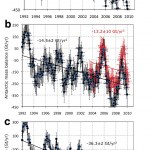earth science
There has been a major dust-up in the climate denialist world. A study published in late July made false claims and was methodologically flawed, but still managed to get published in a peer reviewed journal. The Editor-in-Chief of that journal has resigned to symbolically take responsibility for the journal's egregious error of publishing what is essentially a fake scientific paper, and to "protest against how the authors [and others] have much exaggerated the paper's conclusions" taking to task the University of Alabama's press office, Forbes, Fox News and others.
Let me break it down for…
The Inspector General of the National Science foundation has completed an investigation into falsifying research data, concealing or deleting emails or other data, misusing privileged information, and seriously deviating form accepted practices in relation to climate change research by climate scientist Michael Mann. This investigation, just completed, confirms what has been determined by other previous investigations:
An Investigatory Committee of faculty members with impeccable credentials has unanimously "determined that Dr. Michael E. Mann did not engage in, nor did he participate in,…
I woke up this morning and the world was slightly different than it was the night before. Well, it probably always is a little different each day, but there are certain times when you notice this. I'm not talking about the bits of siding, roofing, and trees scattered about the landscape because of the very severe thunderstorm we had last night, although I suppose this is indirectly related.
If you are not a Minnesotan this will take some explanation:
Don Shelby newscaster, was the Walter Cronkite of the Twin Cities. Stately in appearance, white-haired (since birth, presumably), deep…
These masses of ice are now contributing more new meltwater to the world's seas than all other melting ice combined.
The Greenland and Antarctic ice sheets are losing mass at an accelerating pace, according to a new NASA-funded satellite study. The findings of the study -- the longest to date of changes in polar ice sheet mass -- suggest these ice sheets are overtaking ice loss from Earth's mountain glaciers and ice caps to become the dominant contributor to global sea level rise, much sooner than model forecasts have predicted.
The nearly 20-year study reveals that in 2006, a year in which…
How old is the earth?
Short answer: 4,540,000,00/H30 Earth-years, plus or minus 1%.
Long answer: We don't know exactly because direct dating of the earliest material on the surface of the Earth will only tell use a minimum age; Prior to that, the Earth's surface was probably molten, and even after that, it may be that the earliest non-molten material has been recycled into the planet's interior by tectonic processes. Also, the earth is a big round ball of stuff that condensed into this shape from part of a large disk-shaped blob of stuff known as the Solar Nebula. When exactly, given this,…
I am speaking of Representative John Shimkus, R-Ill, and the truly astonishing words he uttered before Congress demonstrated in a video that is constnatly being trolled off Google and YouTube by those who don't want you to see it:
Source and more information here.
If God's Word is infallible, unchanging, and perfect, then dinosaurs did not live in a different era than humans, and not in great antiquity, and what geologists and paleontologists say about the "age of dinosaurs" must be the word of Satan designed by the dark lord of the underworld to confuse us.
If God's Word is infallible,…
You've heard that the Arctic ice cap has shrunk, and that there are sea lanes open in the northern summer that had not been open previously, and on and so forth.
Since the start of the satellite record in 1979, scientists have observed the continued disappearance of older "multiyear" sea ice that survives more than one summer melt season. Some scientists suspected that this loss was due entirely to wind pushing the ice out of the Arctic Basin -- a process that scientists refer to as "export." In this study, Ron Kwok and Glenn Cunningham at NASA's Jet Propulsion Laboratory in Pasadena, Calif…
As global warming progresses, habitats change in their suitability for various life forms. It may be that moose will not be able to live in Minnesota in the future; Of the two resident moose populations, the one that lives in the area more affected by global warming has pretty much died out probably due indirectly to the effects of increased temperature. There are regions of the rockies where entire forests are dead because of temperature changes. And so on.
Imagine a large flat landscape. As one moves north vs. south, average annual temperature changes, as does the number of days of…
Interesting to look back at this now that the Arctic Ice Cap is opening up and disappearing:
A new NASA study shows that the rising frequency and intensity of arctic storms over the last half century, attributed to progressively warmer waters, directly provoked acceleration of the rate of arctic sea ice drift, long considered by scientists as a bellwether of climate change.
NASA researcher Sirpa Hakkinen of Goddard Space Flight Center in Greenbelt, Md., and colleagues from Woods Hole Oceanographic Institution, Woods Hole, Mass., and the Arctic and Antarctic Research Institute, St. Petersburg…
Weather systems in the Southern and Northern hemispheres will respond differently to global warming ... the warming of the planet will affect the availability of energy to fuel extratropical storms, or large-scale weather systems that occur at Earth's middle latitudes. The resulting changes will depend on the hemisphere and season, the study found.
More intense storms will occur in the Southern Hemisphere throughout the year, whereas in the Northern Hemisphere, the change in storminess will depend on the season -- with more intense storms occurring in the winter and weaker storms in the…
This is astonishing.
...Scientists and conservationists are expressing alarm at the appearance of thousands of walrus on Alaska's northwest coast, a dramatic demonstration of the effects of diminished Arctic sea ice brought on by global warming....
source
I've noticed that a lot of smart people who nonetheless "did not accept" AGW, or at least, denied the "A" part of it, have stoped talking about it lately. I'm speaking here of people I know personally. You know who you are, and you know you were wrong, and I just wanted to say that I forgive you. Mostly.
In the mean time, have a look at this:
That is from NOAA's new Climate Services site, where you too can mess around with the data and get the bejeebus scared out of you. Click here. If you dare.
They need a graph for pirates.
This Rob Dunbar is NOT Robin Dunbar the Archaeologist.
Rob Dunbar hunts for data on our climate from 12,000 years ago, finding clues inside ancient seabeds and corals and inside ice sheets. His work is vital in setting baselines for fixing our current climate -- and in tracking the rise of deadly ocean acidification.
In the 1960s, the whole idea of a "greenhouse effect" was well understood, and assumed to be an important potential factor in climate change. So was glaciation, and the short and medium term future of the Earth's climate was less clear than compared to now. But the basics were there ... C02 was being released into the atmosphere, this could cause a greenhouse effect, and that would warm the earth. Certainly by the early 1980s, it was possible to make some thumb-suck estimates of how much the earth would warm given various assumptions about CO2, and it was not that difficult to see that a lot…
Why does the wind blow, and why does it blow the way it does?
When I teach human evolution, I feel compelled to bring in climate change. When I do that, I find it very unsatisfying to mention climate change as a thing that simply happened. I need to also discuss how climate itself works, both now (in the present era) and generally speaking. That can be hard. There are so many variables that matter, and that if you leave out will come back and bite you later when you suddenly need them to explain something. Anyway, when addressing climate and how it works, it is very difficult to not…
See the missing bit? That is a 1.5 kilometer retreat of the so-called "calving front" of the glacier.
In truth, this particular sort of even is not that unusual, but what is interesting is that new satellite monitoring capabilities allow researchers to notice these events more or less when they happen, as opposed to during less frequent inspections of satellite imagery.
And, there are some climate-change related features of this event.
"While there have been ice breakouts of this magnitude from Jakonbshavn and other glaciers in the past, this event is unusual because it occurs on the…
Anthropogenic global warming has been suspected for decades, and a simple one paragraph long characterization of the problem 40 years ago was substantially identical to any accurate characterization we might make today. One has to wonder why after 40 years of time we still see headlines telling us that it might, after all, turn out to be true that anthropogenic global warming is real. Indeed, it is a bit disconcerting when the inestimable climate blog RealClimate notes that this is the 35th "Anniversary of Global Warming" as a term in the peer reviewed scientific literature (though I…
The Triassic is old. This book is new. That is a hard to beat combination.
Let's see ... The Triassic is about here:
(You can also look it up in this PDF file supplied by the USGS.
It is situated between two major extinction events, and is especially interesting because it is during this period that modern day ecological systems and major animal groups took a recognizable form. The preceding Permian, if contrasted with modern day, would form a very stark contrast while the Triassic would be at least somewhat more recognizable.
But of course the Triassic was in many ways distinct,…
tags: What do You Remember About Mt St Helens' Violent Eruption?, volcano, Mt St Helens, earth science, earth science
Mt St Helens eruption, as photographed by NOAA GOES-3 satellite.
Image: NOAA, US Government (public domain) [larger view].
These videos provide a glimpse of what I (and other people in the area) experienced in the aftermath of the Mt St Helens explosion:
Ash that I collected off the hood of the neighbor's car:
A jar of Mt St Helens Ash from the 0832 eruption on 18 May 1980.
This explosive eruption sent ash 24,400 meters (80,000 feet) into the sky,
generated an…
Various environmental organizations have been using imagery of dead baby birds with toothbrushes in their guts and solid floating masses of garbage to describe and raise alarm about what has become known as the North Pacific Central Garbage Patch. Yet, the small but important amount of research that has been done there shows that the NPCGP consists of many (alarmingly many) pieces of plastic that are very small, the largest being "about the size of the fingernail on your pinkey."
Albatross may or may not be affected by garbage, but it is not likely that the garbage shown in the guts of…


